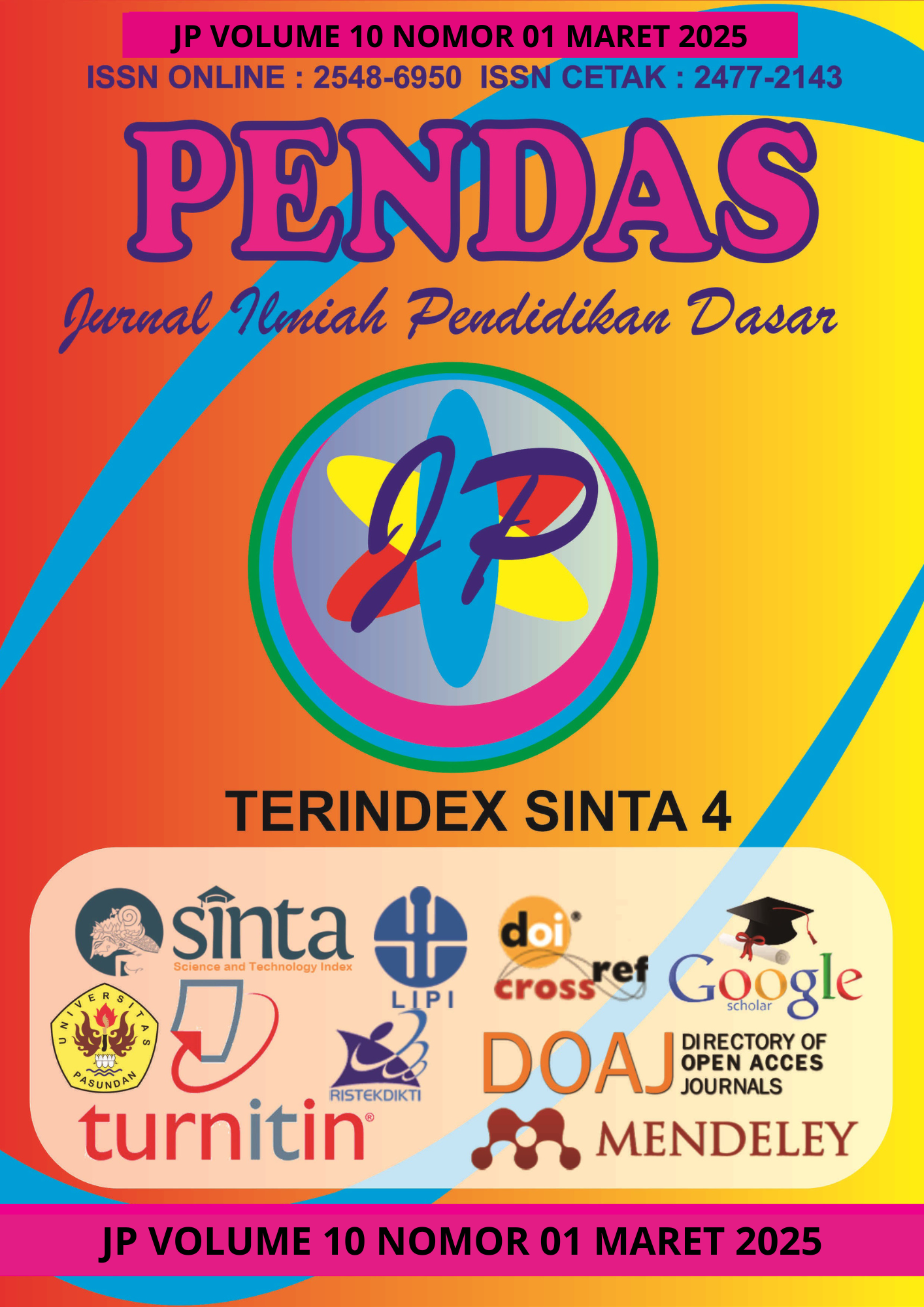EFEKTIVITAS PENGGUNAAN MODEL PEMBELAJARAN STEM TERHADAP LITERASI NUMERASI SISWA SD
DOI:
https://doi.org/10.23969/jp.v10i01.23443Keywords:
STEM, learning model, numeracy literacyAbstract
STEM is an interesting learning model. The following research was carried out based on the aim of determining numeracy literacy abilities. This research was carried out with the aim of finding out the effectiveness of using the STEM learning model on students' numeracy literacy abilities. In this research, the samples used were Kleco and Bungkuk Elementary Schools. Data collection in this research used observation, interview and test techniques. In the following research, the T test is used as a hypothesis test. Based on the following research activities, the results showed that the STEM model was effective on the numeracy literacy abilities of elementary school students.
Downloads
References
Ate, D., & Lede, Y. K. (2022). Analisis Kemampuan Siswa Kelas VIII dalam Menyelesaikan Soal Literasi Numerasi. Jurnal Cendekia: Jurnal Pendidikan Matematika, 06(01), 472–483.
Aydin, G. (2020). Prerequisites for elementary school teachers before practicing STEM education with students: A case study. Eurasian Journal of Educational Research, 2020(88), 1–40. https://doi.org/10.14689/ejer.2020.88.1
Coben, D. (n.d.). What is specific about research in adult numeracy and mathematics education? In Adults Learning Mathematics-an International Journal.
Ekowati, D. W., Astuti, Y. P., Utami, I. W. P., Mukhlishina, I., & Suwandayani, B. I. (2019). Literasi Numerasi di SD Muhammadiyah. ELSE (Elementary School Education Journal) : Jurnal Pendidikan Dan Pembelajaran Sekolah Dasar, 3(1), 93. https://doi.org/10.30651/else.v3i1.2541
Erlinawati, C. E., Bektiarso, S., & maryani. (2019). Model Pembelajaran Project Based Learning Berbasis Stem Pada Pembelajaran Fisika. Seminar Nasional Pendidikan Fisika, 4(1), 1–4.
Falloon, G., Hatzigianni, M., Bower, M., Forbes, A., & Stevenson, M. (2020). Understanding K-12 STEM Education: a Framework for Developing STEM Literacy. Journal of Science Education and Technology, 29(3), 369–385. https://doi.org/10.1007/s10956-020-09823-x
Felstead, P., & Hunter, K. (2018). Developing Pre-Service Teachers: The Impact of an Embedded Framework in Literacy and Numeracy. In Australian Journal of Teacher Education (Vol. 43, Issue 4). http://ro.ecu.edu.au/ajte/vol43/iss4/1Retrievedfromhttp://ro.ecu.edu.au/ajte/vol43/iss4/1
Ilhan, A., Tutak, T., & Celik, H. C. (2019). What is the predictive power of visual mathematics literacy perception and its sub-dimensions for geometry success? Eurasian Journal of Educational Research, 2019(80), 1–24. https://doi.org/10.14689/ejer.2019.80.1
Katranci, Y., & Şengül, S. (2019). The relationship between mathematical literacy and visual math literacy self-efficacy perceptions of middle school students. Pegem Egitim ve Ogretim Dergisi, 9(4), 1113–1138. https://doi.org/10.14527/pegegog.2019.036
Lange, J. De. (2006). Tsukuba Journal Of Educational Study In Mathematics. Tsukuba Journal Of Educational Study In Mathematics, 25 (Innovative Teaching Mathematics Through Lesson Study), 14–15.
Lestari, D. A. B., Astuti, B., & Darsono, T. (2018). Implementasi LKS Dengan Pendekatan STEM (Science, Technology, Engineering, And Mathematics) Untuk Meningkatkan Kemampuan Berpikir Kritis Siswa. Jurnal Pendidikan Fisika Dan Teknologi, 4(2), 202–207. https://doi.org/10.29303/jpft.v4i2.809
Li, Y., Wang, K., Xiao, Y., Froyd, J. E., & Nite, S. B. (2020). Research and trends in STEM education: a systematic analysis of publicly funded projects. International Journal of STEM Education, 7(1). https://doi.org/10.1186/s40594-020-00213-8
Mahmud, M. R., & Pratiwi, I. M. (2019). Literasi Numerasi Siswa Dalam Pemecahan Masalah Tidak Terstruktur. KALAMATIKA Jurnal Pendidikan Matematika, 4(1), 69–88. https://doi.org/10.22236/kalamatika. vol4no1.2019pp69-88.
Mann, E. L., Mann, R. L., Strutz, M. L., Duncan, D., & Yoon, S. Y. (2011). Integrating Engineering Into K-6 Curriculum: Developing Talent in the STEM Disciplines. Journal of Advanced Academics, 22(4), 639–658. https://doi.org/10.1177/1932202X11415007
Novalia, E. (2017). Analisis Kemampuan Literasi Matematika dan Karakter Kreatif pada Pembelajaran Synectics Materi Bangun Ruang Kelas Viii. 6(2), 225–232.
Nurhikmayati, I. (2019). Implementasi STEAM Dalam Pembelajaran Matematika. Didactical Mathematics, 1(2), 41–50. https://doi.org/10.31949/dmj.v1i2.1508
O’donoghue, J. (2002). Numeracy and Mathematics. In Irish Math. Soc. Bulletin (Vol. 48).
Roehrig, G. H., Moore, T. J., Wang, H.-H., & Park, M. S. (2012). Is Adding the E Enough? Investigating the Impact of K-12 Engineering Standards on the Implementation of STEM Integration. School Science and Mathematics, 112(1), 31–44. https://doi.org/10.1111/j.1949-8594.2011.00112.x
Sa’adah, S. K., & Sudarmin, S. (2021). Pembelajaran Dengan Pendekatan Stem Terintegrasi Science Entrepreneurship Untuk Mengembangkan Karakter Kewirausahaan. Jurnal Inovasi Pendidikan …, 15(1), 2778–2791. https://journal.unnes.ac.id/nju/index.php/JIPK/article/view/25898
Sholahudin, U. (2018). Penerapan Pendidikan Matematika Realistik (PMR) Untuk Meningkatkan Kemampuan Literasi Matematika Siswa Kelas IV SDN 03 Cimaung Serang. Jurnal Pendidikan Matemtika, 01(01), 66–73.
Sugiono.2016. Metode Penelitian Pendidikan: pendekatan kuantitatif, kualitatif, dan R&D. Bandung: Alfabeta.
Downloads
Published
Issue
Section
License
Copyright (c) 2025 Pendas : Jurnal Ilmiah Pendidikan Dasar

This work is licensed under a Creative Commons Attribution 4.0 International License.



















